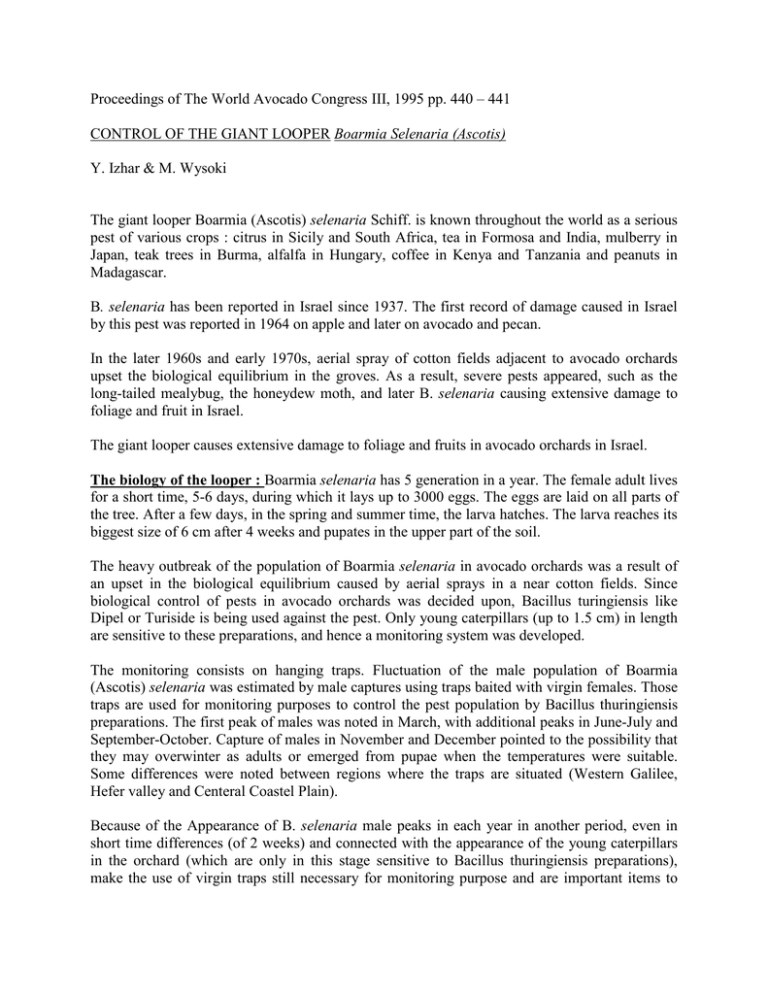Proceedings of The World Avocado Congress III, 1995 pp. 440 –... Boarmia Selenaria (Ascotis) Y. Izhar & M. Wysoki
advertisement

Proceedings of The World Avocado Congress III, 1995 pp. 440 – 441 CONTROL OF THE GIANT LOOPER Boarmia Selenaria (Ascotis) Y. Izhar & M. Wysoki The giant looper Boarmia (Ascotis) selenaria Schiff. is known throughout the world as a serious pest of various crops : citrus in Sicily and South Africa, tea in Formosa and India, mulberry in Japan, teak trees in Burma, alfalfa in Hungary, coffee in Kenya and Tanzania and peanuts in Madagascar. B. selenaria has been reported in Israel since 1937. The first record of damage caused in Israel by this pest was reported in 1964 on apple and later on avocado and pecan. In the later 1960s and early 1970s, aerial spray of cotton fields adjacent to avocado orchards upset the biological equilibrium in the groves. As a result, severe pests appeared, such as the long-tailed mealybug, the honeydew moth, and later B. selenaria causing extensive damage to foliage and fruit in Israel. The giant looper causes extensive damage to foliage and fruits in avocado orchards in Israel. The biology of the looper : Boarmia selenaria has 5 generation in a year. The female adult lives for a short time, 5-6 days, during which it lays up to 3000 eggs. The eggs are laid on all parts of the tree. After a few days, in the spring and summer time, the larva hatches. The larva reaches its biggest size of 6 cm after 4 weeks and pupates in the upper part of the soil. The heavy outbreak of the population of Boarmia selenaria in avocado orchards was a result of an upset in the biological equilibrium caused by aerial sprays in a near cotton fields. Since biological control of pests in avocado orchards was decided upon, Bacillus turingiensis like Dipel or Turiside is being used against the pest. Only young caterpillars (up to 1.5 cm) in length are sensitive to these preparations, and hence a monitoring system was developed. The monitoring consists on hanging traps. Fluctuation of the male population of Boarmia (Ascotis) selenaria was estimated by male captures using traps baited with virgin females. Those traps are used for monitoring purposes to control the pest population by Bacillus thuringiensis preparations. The first peak of males was noted in March, with additional peaks in June-July and September-October. Capture of males in November and December pointed to the possibility that they may overwinter as adults or emerged from pupae when the temperatures were suitable. Some differences were noted between regions where the traps are situated (Western Galilee, Hefer valley and Centeral Coastel Plain). Because of the Appearance of B. selenaria male peaks in each year in another period, even in short time differences (of 2 weeks) and connected with the appearance of the young caterpillars in the orchard (which are only in this stage sensitive to Bacillus thuringiensis preparations), make the use of virgin traps still necessary for monitoring purpose and are important items to improve the control of the pest. At the beginning of this investigations the traps were put out in the avocado orchards for a long period (some times a year) and sprays were performed with or shortly after the appearance of the moth. At present, the traps are in the avocado orchards only from February to June, and the control is directed against young larva of the first or second generation through B. thuringiensis applied on aerial sprays. The traps are hung in march and are controlled during spring and summer. Once a week the virgin females in the traps are changed and the observation of the traps is done every second day. When the level of 10 male butterfly is observed we search for caterpillars on the leaves and fruits. When we have 5-10 caterpillars per tree we spray B.T. preparation and sticker by helicopter crosswise. The advantages of using B. T. are: 1) its long residual effect (up to 6 weeks). 2) harmlessness to parasitic wasps and honey bees. 3) non phytotxicity. 4) effectiveness against another avocado pest like honeydew moth. KEYWORDS: Boarmia (Ascotis) selentria - Virgin females-baited traps - Pheromones Population dynamics - Bacillus thuringiensis - Avocado.



